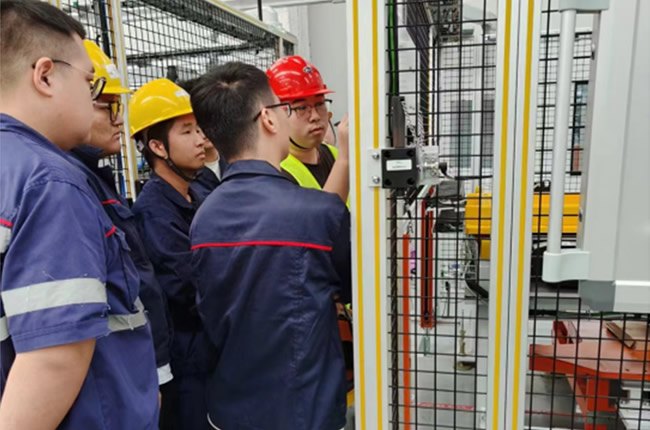We can help customers develop process plans, plan equipment configurations, and provide one-stop services and equipment solutions from process development to product trial production, from initial trial production to final mass production.
ㆍProcess development
Work piece pressure estimation, formulation of press fitting process, formulation of testing standards for press fitting process, work piece classification, loading, unloading, and screening process, etc.
ㆍTrial press fitting of work pieces
Perform trial press fitting of the work piece according to the customer's process requirements, and provide testing report or video.
ㆍLeasing
Can lease our equipment or we can provide small batch press fitting services.
ㆍInstallation
We install the equipment in place and conduct independent trial runs
ㆍTraining
Equipment usage training, common alarm training, signal training
ㆍLocal and remote technical support
ㆍCalibration services
ㆍEmergency maintenance or standby machine service
ㆍSpare parts services


Brief information on common product Q&A
1. Structurally speaking, large electric push rod transmissions are all worm gear structures, and small electric push rod transmissions are all small gear transmissions, all such transmission methods are low efficient; While the servo electric cylinder is driven by synchronous belt or direct transmission, which has a relatively high transmission efficiency.
2. In terms of control, electric push rods are mostly ordinary three-phase motors or direct connection electric motors, and their control is relatively simple. While the servo electric cylinder is usually used with a servo motor, the control is quite complex.
3. In terms of application scenarios, electric push rods are more commonly used in ordinary industrial applications, such as windowing and acting as pins, while servo electric cylinders are more commonly used in high-precision and advanced occasions due to the high precision and high transmission efficiency.
Servo electric cylinder is a modular product that integrates servo motor and guide screw, with the speed of 0.1~2m/s. Due to its closed-loop servo control, the control accuracy is high. With the characteristics of low cost and flexible configuration, it is the best substitute for hydraulic cylinders and air cylinders, and it is widely used in industry, military, entertainment facilities, automobiles, etc. This article introduces the advantages of servo electric cylinders.
Advantages:
1. Closed-loop servo control, accuracy can reach 0.01mm;
2. Precision control of thrust, with pressure sensors added, the control accuracy is up to 1%;
3. It is easy to connect with PLC and other control systems to achieve high-precision motion control.
4. Low noise, energy-saving, clean, high rigidity, impact resistance, ultra long service life, simple operation and maintenance.
5. The servo cylinder can operate without faults in harsh environments with a protection level of up to IP66.
6. Long term work, achieving high intensity, high speed, high-precision positioning, smooth operation, and low noise.
7. Low maintenance cost: Servo electric cylinders only require regular grease lubrication when working in complex environments, and there are no vulnerable parts that need to be maintained or replaced, reducing a significant amount of after-sales service costs compared to hydraulic and pneumatic systems.
8. Flexible configuration: It can provide very flexible installation configurations, with a full range of installation components including, installations of front flange, rear flange, side flange, rear hinge, trunnion, guide module, etc.; It can be installed with the servo motor in a straight line position or parallel position; It can be added with various accessories, such as limit switches, planetary reducers, pre-fastening nuts, etc.; And its drive options include AC brake motor, DC motor, stepper motor, and servo motor.
Application areas:
1. Other places that can replace the use of hydraulic and pneumatic equipment as the upgraded products of hydraulic and pneumatic equipment, and fully electric Multi-DOF platforms, etc.
2. Experimental equipment: high-frequency vibration table, high-frequency impact table, simulation platform, test bed, wave maker;
3. Special equipment: Industrial automation production lines, assembly lines, coordinate machinery, elevating platform, deviation control, valve control, mechanical equipment, food and pharmaceutical industry, CNC machine tools, industry packaging machines, automotive electronic pressing machines, textile equipment winding machine indexing, mold position control, clamping, drilling, positioning, automatic adjustment control, etc.;
4. Military equipment: Special equipment, such as, radar support frame, launch platform lifting mechanism, missile erector, hatch opening cylinder, artillery elevation drive device, vehicle body electric leveling mechanism, missile hull turnover mechanism, mine sweeping robot arm, 6-DOF swing mechanism, track adjustment mechanism, extractor mechanism, shelter expansion mechanism, etc.
The servo cylinder can operate without faults in harsh environments, and work for long term, achieving high intensity, high speed, high-precision positioning, smooth operation, and low noise. So it is widely used in the papermaking industry, chemical industry, automotive industry, electronics industry, mechanical automation industry, welding industry, etc. Then, how does a servo press realize the pressure control?
1. Displacement control mode:
During the press fitting process, as the displacement changes, the pressure also changes accordingly. We can monitor the pressure changes at any time during the press fitting process through the built-in pressure sensor and high-speed data acquisition card. When the pressure reaches the maximum pressure we set, it immediately stops to achieve the purpose of pressure control.
2. Torque control mode:
The torque control method of servo electric cylinder is to set the output torque of the motor shaft through the input of external analog signals or direct address assignment. We can calibrate the correspondence between torque and pressure through a calibration program, to achieve the control of pressure by controlling torque.
The E-Join servo press fitting system combines the above two methods, and optimizes the internal algorithm of the system to achieve the purpose of precise pressure control. The pressure accuracy can reach ± 1% of the maximum range. Thereby, it can achieve high-precision motion pressure control, with the characteristics of low noise, energy-saving, clean, high rigidity, impact resistance, ultra long service life, simple operation and maintenance.
Servo electric cylinder is a modular product that integrates servo motor and screw, which converts the rotational motion of servo motor into linear motion through screw. At the same time, it precisely controls the best advantages of the rotating speed of servo motor, transforms precise speed control and precise torque control into precise speed control, precise position control, and precise thrust control, achieving revolutionary products of high-precision linear motion series.
Regarding the selection of electric cylinders types, we should pay attention to the following matters:
1. Firstly, it is necessary to clarify the issue of the effective stroke of the electric cylinder. Its unit is mm. The stroke actually represents the effective travel distance of the electric cylinder. Generally speaking, for low speeds below 100mm/s, it is not a problem to add about 20mm of travel on top of the effective stroke we can see. In order to avoid collisions at the end of the electric cylinder, we can appropriately increase its margin when its speed is high, to facilitate debugging, more importantly, to avoid collisions at the front and rear limit positions.
2. We need to pay attention to its rated speed, the unit of which is mm/s. It is used to determine the rated speed of the electric cylinder at full load. This speed can directly determine the driving power of the electric cylinder on the motor. To determine the appropriate speed based on one's actual needs can effectively avoid waste.
3. Also need to pay attention to the rated output, the unit of which is N or kgf. Here we need to know the consistency between its pushing force and pulling force. And for the entire journey, its output is also the same. So it is necessary to choose according to the actual situation and leave a certain margin.
4. We need to talk about its positioning accuracy, the unit of which is mm, which usually refers to repeated positioning accuracy. The accuracy varies according to different structures, and the maximum accuracy is up to 0.02mm.